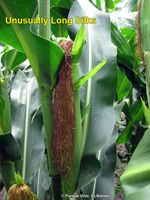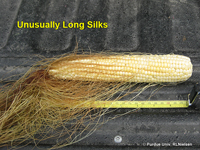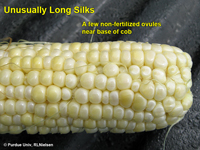larger versions.

Unusually long silks.

Unusually long silks
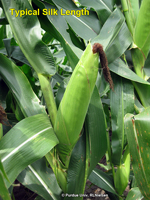
Normal length silks.
July 2018
URL: http://www.kingcorn.org/news/timeless/LongSilks.html
Unusually Long Silks in Corn
R.L. (Bob) Nielsen
Agronomy Dept., Purdue Univ.
West Lafayette, IN 47907-2054
Email address: rnielsen at purdue.edu
Twitter: @PurdueCornGuy
![]() he other day, one of the patrons of Rudy's Bar and Grill walks in with an ear of corn that exhibited long, flowing locks of blonde silks tumbling down the sides of the husk leaves and asked two questions: "Why are the silks so long?" and "Do such long silks bode ill for the success of corn pollination?" Well, maybe the 2nd question was couched in more earthy terms, but you get the drift.
he other day, one of the patrons of Rudy's Bar and Grill walks in with an ear of corn that exhibited long, flowing locks of blonde silks tumbling down the sides of the husk leaves and asked two questions: "Why are the silks so long?" and "Do such long silks bode ill for the success of corn pollination?" Well, maybe the 2nd question was couched in more earthy terms, but you get the drift.
Both questions suggest that the guy has some experience thinking about sex in a corn field and understands that silks are the functional stigmas of the female flowers of a corn plant. Each silk connects to an individual ovule (potential kernel) and must be pollinated in order for fertilization of the ovule to occur and a kernel develop. The guy also seems to know that emerged silks are typically only 2 to 3 inches long; not 6 to 9 inches long like those on the ear he brought in.
Silks begin elongating from the ovules near the base of an ear shoot sometime around leaf stage V12 to V14, followed by silk elongation from the remaining ovules of the ear shoot, sequentially from base to tip of ear. The silks from ovules from the lower third of the cob are typically the first to emerge through the husk leaves; followed sequentially by the remaining silks over a 4 to 8 day period.
Emerged silks initially lengthen from 1 to 2 inches per day, but then slow over the next few days due to natural aging or the inhibition caused by "captured" pollen grains as they germinate and initiate pollen tubes that penetrate the silk and elongate toward the ovule. The latter inhibition of silk elongation occurs within about 12 hours of pollination, if not earlier.
If no pollen is available, silk elongation will continue but eventually slows to a stop within about 9 days after emergence, the result of which is indeed longer than expected silks. Traditionally we agronomists point to the effects of severe drought stress that often speeds up tassel maturation and pollen shed, but delays silk emergence. Hence, when silks finally emerge from the husks, pollen shed may already be finished and no pollen available for the silks.
Most of us "gray beard" agronomists were taught that full tassel emergence (growth stage VT) often occurred 2 to 3 days before the first emergence of silks (growth stage R1). In fact, the verbatim definition of the VT stage from Ritchie et al. (1993) was that "The VT stage is initiated when the last branch of the tassel is completely visible and the silks have not yet emerged." Furthermore, pollen shed often began before or just at the timing of silk emergence.
Corn field aficionados will tell you that the timing of tassel emergence / pollen shed / silk emergence has changed somewhat in some of today's hybrids. In my own demo plots at the Purdue Crop Diagnostic Training & Research Center, it is not uncommon for silks to begin emerging before the tips of the tassels are evident from the upper leaf whorl. Sometimes pollen shed begins 2 to 4 days AFTER the initial emergence of silks from the ear husks. Such early silk emergence in modern hybrids is partially due to genetic improvement for drought tolerance that decreases the risk of delayed silk emergence in the presence of drought stress. This more robust silk elongation can result in unusually early silk emergence when growing conditions are more favorable (personal communication, K. Cavanaugh, Becks Hybrids).
Relatively cool temperatures, cloudy weather, and ample soil moisture promote sustained silk elongation. Coupled with hybrids that may silk one or more days prior to pollen shed from the tassel, silk lengths can become quite impressive.
Can there be a downside to such wonderfully long, voluptuous, silky...........silks? Well, yes, kernel set near the base of the cob may fail if the initial emerged silks deteriorate enough prior to pollen shed that they become non-receptive. Kernel set near the butt end of the cob may also fail if later-emerging silks from higher up on the ear "shade" or otherwise obstruct the initial emerged silks from "capturing" pollen. The images below illustrate the potential for non-pollinated areas near the base of the cob in a hybrid that silked several days prior to the beginning of pollen shed.
In the past week or two, I have seen a number of corn fields with noticeably lengthy silks and, often, tassels not yet shedding pollen. Because this phenomenon can result in poor kernel set, and lower grain yield, it may behoove you to check fields soon for the success of pollination and kernel set.
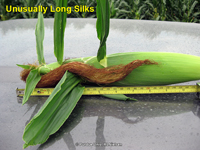

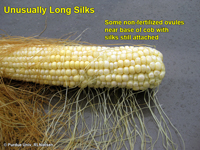
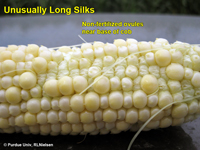
Unusually long silks and corresponding poor kernel set near the base of the cob. Click on images to view larger versions.
The images below illustrate another example of unusually lengthy silks from the same hybrid, but with only minor kernel set problems. Thus, the existence of unusually long silks by themselves do not automatically result in poor kernel set.
Bottom Line?
While unusually long silks are, well, unusual, don't get overly pessimistic about the prospects of poor kernel set as a consequence. Time spent now walking fields during the early stages of grain fill may help provide an overview of the extent of the problem if any.
Related References
Bassetti, Paolo and Mark Westgate. 1993. Emergence, Elongation, and Senescence of Maize Silks. Crop Sci. 33:271-275.
Cárcova, J., B. Andrieu, and M.E. Otegui. 2003. Silk Elongation in Maize: Relationship with Flower Development and Pollination. Crop Sci. 43:914-920.
Nielsen, RL (Bob). 2016. A Fast & Accurate Pregnancy Test for Corn. Corny News Network, Purdue Extension. http://www.kingcorn.org/news/timeless/EarShake.html [Accessed July 2018].
Nielsen, RL (Bob). 2016. Silk Emergence. Corny News Network, Purdue Univ. [online] http://www.kingcorn.org/news/timeless/silks.html [Accessed July 2018].
Nielsen, RL (Bob). 2017. Kernel Set Scuttlebutt. Corny News Network, Purdue Extension. http://www.kingcorn.org/news/timeless/KernelSet.html [Accessed July 2018].
Ritchie, S.W., J.J. Hanway, and G.O. Benson. 1993. How a Corn Plant Develops. Iowa State Univ. Sp. Rpt. 48.
Sella Kapu, N. U., & Cosgrove, D. J. 2010. Changes in growth and cell wall extensibility of maize silks following pollination. Journal of Experimental Botany, 61(14), 4097–4107. http://doi.org/10.1093/jxb/erq225.
